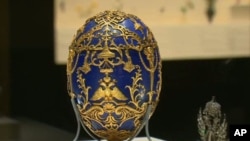People are fascinated by the objects created by Karl Fabergé, not just because they are beautiful and crafted from precious metals and jewels, but also because they are associated with the last tsar of Russia, Nicholas II and his family, who were murdered in 1918 by the Bolsheviks during the Russian revolution.
“One of the major reasons people bought and buy Fabergé is the connection with the imperial family. He was very close to them and they commissioned things for their personal use,” says Geza von Habsburg, curator of the exhibition, “Fabergé Revealed” at the Virginia Museum of Fine Arts.
Habsburg is a descendant of the 19th century Habsburg rulers of Austria and Hungary, and he's an expert on Fabergé, having written books on his work. Habsburg assembled more than 500 objects, including seven of the jeweler’s most famous works, the Imperial Easter Eggs.
“Only 50 were ever created. Forty or 42 are known to exist. Seven are here all at the same time,” says Alex Nyerges, director of the Virginia Museum of Fine Arts, which has five Imperial Easter Eggs in its permanent collection. “The eggs are miraculous, marvelous works of detail. They are not just works of art in terms of beauty, but they are mechanically precise.”
Each egg has moveable parts and a surprise inside. The most precious are estimated to be worth up to $30 million dollars. They were commissioned as Easter gifts beginning in 1885, by Alexander III for his wife. His son, Nicholas II, continued the tradition.
One Imperial Egg is made of lapis lazuli and gold. Inside is a portrait of the tsar's son painted on ivory and framed by platinum and diamonds.
Another golden egg, is known as the Pelican Egg, because of the enameled bird that sits on top of it. It opens into eight miniature paintings.
However, the Imperial Easter Eggs represent only a small portion of Fabergé’s production.
During his career, he employed 500 people and his workshop produced over 150,000 unique objects. Not all were for the tsar’s family.
Fabergé was also a silversmith who created the Russian crown jewels. But very little jewelry or silver remains.
“Of the jewelry, 95 percent was destroyed by the Bolsheviks," says von Habsburg. "Of the silver, 95 percent was melted down by the Bolsheviks. They were in dire need of money after the revolution.”
What they didn't destroy, they sold to collectors.
“These works started coming out of Russia in the 1920s and the 1930s, and there was a great mania for collecting Fabergé starting in the 1930s in this country," says Nyerges. "And there were a couple of key collectors.”
Lillian Pratt was one of them. When she died in 1947, she bequeathed more than 150 Fabergé pieces to the Virginia Museum. Today, it houses the largest collection of Fabergé outside of Russia.
As for Fabergé, he fled Russia during the revolution and died in Switzerland two years later.













